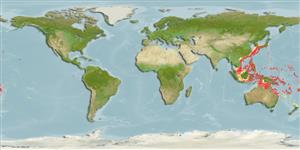Actinopterygii (ray-finned fishes) >
Perciformes (Perch-likes) >
Trichonotidae (Sanddivers)
Etymology: Trichonotus: Greek, thrix = hair + Greek, noton = back (Ref. 45335).
Environment / Climate / Range
Ecology
Marine; reef-associated; depth range 10 - 217 m (Ref. 86942). Temperate, preferred ?
Western Pacific: Japan and China. Recently reported from the Chesterfield Islands (Ref. 11897).
Size / Weight / Age
Maturity: Lm ? range ? - ? cm
Max length : 15.0 cm SL male/unsexed; (Ref. 559)
Short description
Morphology | Morphometrics
Dorsal
soft rays
(total): 43-44. Recognized by the black spot on the head. Males lack dorsal filaments but have a long extended ventral fin ray (Ref. 48636).
Found on sandy bottoms in shallow waters (Ref. 32211). Seen singly or in coastal sand slopes (Ref. 48636). Feed on zooplankton (Ref. 9137).
Life cycle and mating behavior
Maturity | Reproduction | Spawning | Eggs | Fecundity | Larvae
Also Ref. 103751.
Masuda, H., K. Amaoka, C. Araga, T. Uyeno and T. Yoshino, 1984. The fishes of the Japanese Archipelago. Vol. 1. Tokai University Press, Tokyo, Japan. 437 p. (text). (Ref. 559)
IUCN Red List Status (Ref. 115185)
CITES (Ref. 94142)
Not Evaluated
Threat to humans
Harmless
Human uses
More information
Age/SizeGrowthLength-weightLength-lengthLength-frequenciesMorphometricsMorphologyLarvaeLarval dynamicsRecruitmentAbundance
ReferencesAquacultureAquaculture profileStrainsGeneticsAllele frequenciesHeritabilityDiseasesProcessingMass conversion
Tools
Special reports
Download XML
Internet sources
